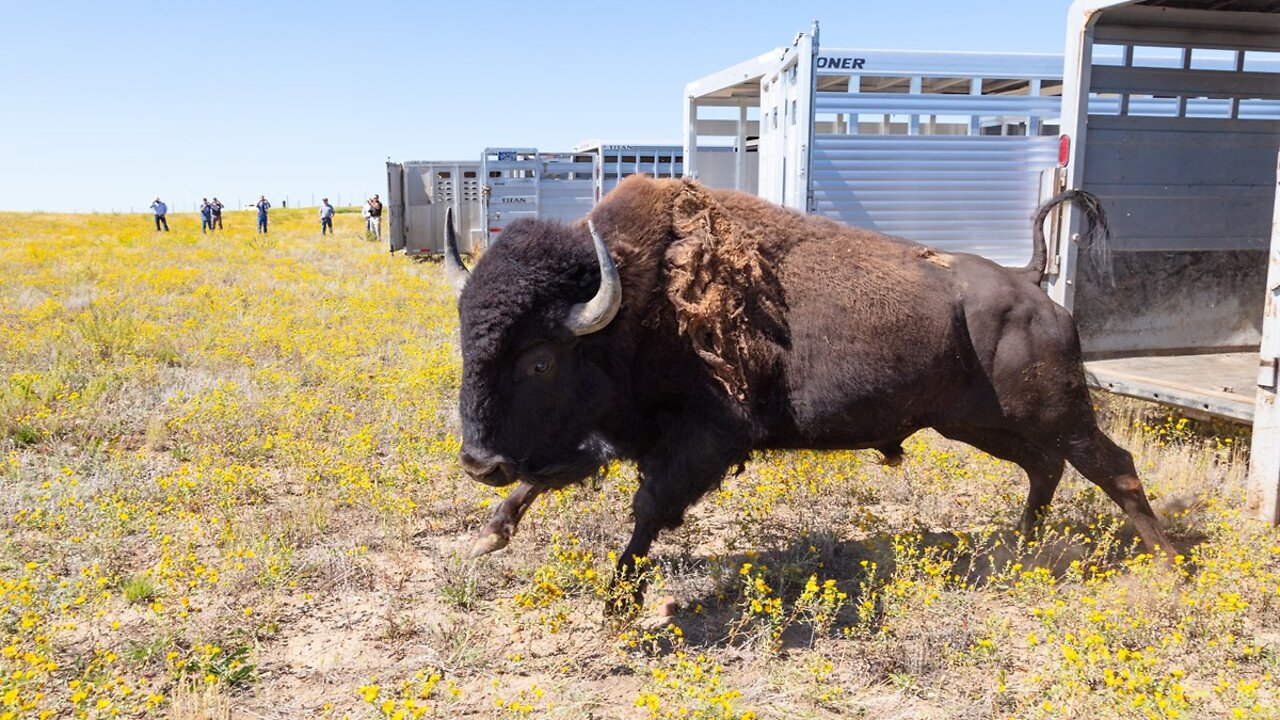Premium Only Content

Handling a bison while transferred
Handling Bison The “Low Stress” Basics:
Bison ( Bison ) form a genus of large ruminant bovids of which there are two living species: the European bison ( Bison bonasus ) and the North American bison ( Bison bison ) which is itself divided into two sub- species: wood bison ( Bison bison athabascae ) and plains bison ( Bison bison bison ). The plains bison lives mainly in the North American steppes while the wood bison and the European bison occupy forest habitats.
Bison and other livestock will respond to pressure we put on them as we place ourselves into their comfort or flight zone. This zone is the area around them that causes them to take notice we are there, and then, if the pressure isn’t removed, to move away from us.
Following are some foundational principles we will have to work on to develop our ranches into “low stress” operations.
Realize that it is our fault, not theirs, if our livestock live in a high stress environment. We will need to change how we operate to affect a better outcome for them. Our attitudes towards our animals and philosophies of animal management will have to change, as they are just operating the best they can in the environment we provide for them.
Consistently use signals that livestock can respond to naturally so they can understand our meaning or what we want them to do. Get consistent in how we move our bison in the pasture, from pasture to pasture or in the corral. Realize that if they become unsettled or emotionally fractured, it is something we did that caused it. Analyze the responses (feedback) we get from our stock, as this is how they are communicating to us. If we are not getting the desired feedback, then we are the problem and will need to change what we are doing.
Apply only the amount of pressure needed to get the desired response, not an ounce more!
Stop “forcing” our bison to do what we want. Replace force with consistent sound handling principles that allow them to learn what we want and gives them opportunity to do it willingly.
Stop doing things that cause immediate “high stress” in our bison such as yelling; moving fast and erratically; not giving them time to think, analyze and respond; putting continued unrelenting pressure on them with no release.
Stop having a definite schedule when working with our bison. We must realize that our “schedule” puts pressure on us that often times is transferred to our bison, which causes its own problems. In working with animals, not every day is the same and how we approach it often times affects the outcome. If we are on edge and in a hurry, the animals will pick up on this and react accordingly.
Start getting on the “other side of the horns.” Spend some time thinking about what we do with our bison and how it may look or feel from their perspective. If we can get inside them and see what we do through their eyes, it well may change how we do things.
If one approach does not work, even if it did yesterday, try another. Conditions are constantly changing and we must account for that with our method and approach. Be flexible in what we do and how we do it.
-
 1:04:52
1:04:52
Geeks + Gamers
5 hours agoDisney RATIO'D on Christmas Day | Mufasa Embarrassed By Sonic 3
37.3K2 -
 LIVE
LIVE
Sm0k3m
9 hours agoPlaying games on Rumble
179 watching -
 10:37
10:37
Russell Brand
2 days agoHow is this even allowed?
162K836 -
 1:37:26
1:37:26
Real Coffee With Scott Adams
6 hours agoEpisode 2701 CWSA 12/26/24
87.4K83 -
 2:58:58
2:58:58
Wendy Bell Radio
11 hours ago9 Steps Ahead
116K138 -
 2:03:46
2:03:46
LFA TV
19 hours agoTIME FOR A NEW SPEAKER! | LIVE FROM AMERICA 12.26.24 11am EST
66.9K41 -
 1:40:22
1:40:22
Game On!
16 hours ago $5.36 earnedNFL Thursday Night Football Seahawks at Bears EXPERT Picks!
50K9 -
 1:50:54
1:50:54
xBuRnTx
6 hours agoWho's Ready for New Years!
36.9K1 -
 12:09
12:09
Tactical Advisor
18 hours agoSmith & Wesson Shield Plus Carry Comp
30.3K2 -
 4:35:25
4:35:25
Father Russell
11 hours agoDelta Force | Not A Woman? | Mad Martigan Time
69.9K5